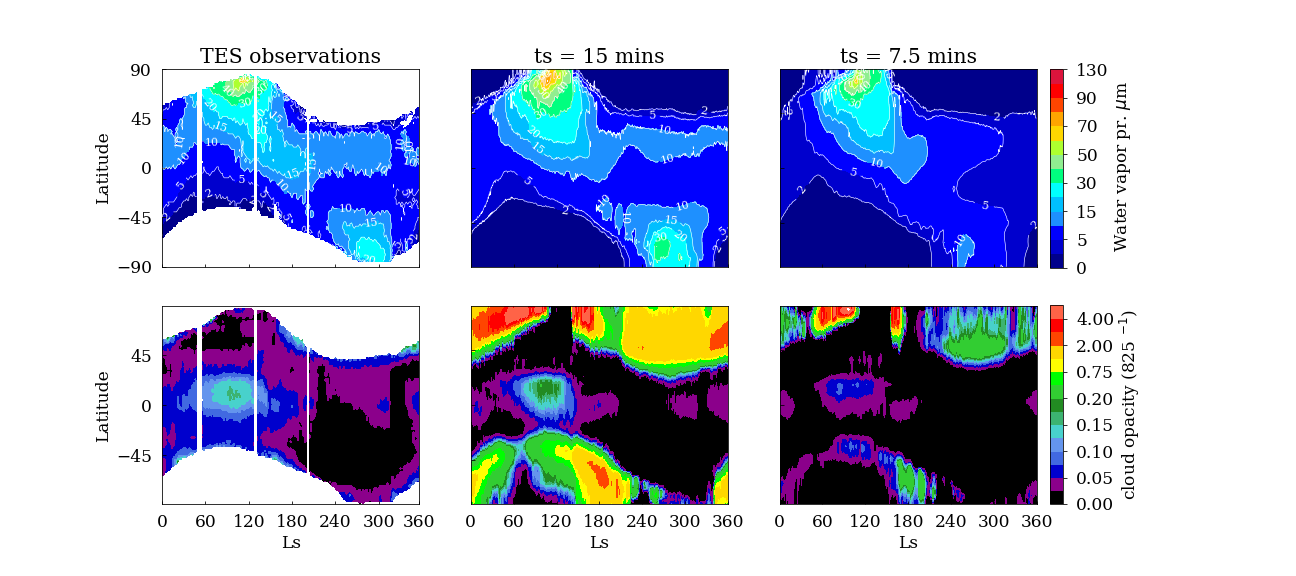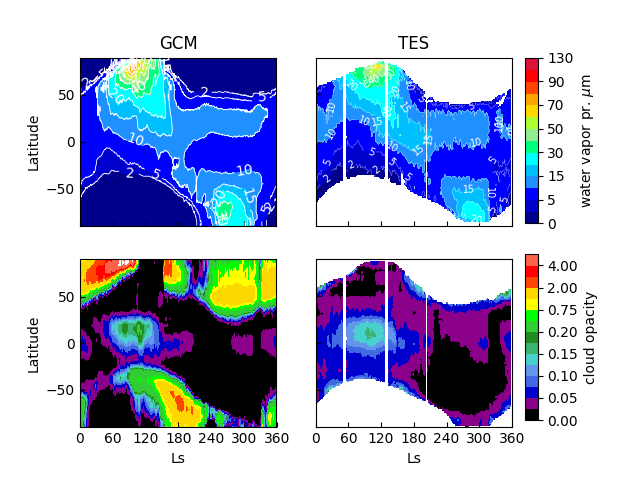| Version 7 (modified by , 4 years ago) (diff) |
|---|
Sensitivity of the Global Water Cycle on Mars to the physical timestep
Author: J. Naar
Date: 09/2021
Standard Global Water Cycle from state of the art Navarro et al. 2014 study
The implementation of Radiatively Active Clouds (RACs) in the GCM, along with a full cloud microphysics scheme, allows for a satisfying agreement between simulated Global Water Cycle and TES observations regarding atmospheric water vapor and cloud opacity. In this configuration, the Northern polar cap is set as an infinite ground ice reservoir avalaible for sublimation. The global water cycle is sensitive to four main parameters listed in the table below.
callphys.def from Navarro et al. 2014
| PARAMETERS | COMMENTS | INTERACTION |
|---|---|---|
| albedo_h2o_ice=0.35 | Frost & Northern water cap albedo | Ground ice |
| inert_h2o_ice= 800 | Water ice thermal inertia | Ground ice |
| mteta = 0.95 | Water contact parameter | Cloud microphysics |
| nuice_sed=0.1 | Size distribution of nuclei | Cloud microphysics |
This physical parametrization is tuned to work with a specific numerical scheme set in the run.def file :
day_step = 960 iphysiq = 10
Those lines mean that the temporal resolution for the integration of the dynamical equations is 1/960 martian sol (~24 martian hours), that is 1.5 martian minute. The physical computation is called every 10 dynamical step, that is with a 15 martian minutes resolution.
What is up with the Global Water Cycle and the RAC feedback ?
The PhD work of Margaux Vals unveiled the intrication between RAC feedback and turbulent mixing and cloud microphysics. As a result, there is a strong sensitivity to the physical resolution for the Global Water Cycle. Some specific features require an increased physical resolution, and in any case one should always use the more realistic parametrization. We find that dividing by 2 the iphysiq parameter substancially dries the Global Water Cycle.
Retuning and improving the Global Water Cycle
The reference study by Navarro et al. 2014 describes the sensitivity of the Global Water Cycle to each of the four main tunables parameters presented in the table above. We focus on the water contact parameter and the albedo of ground ice as they are poorly constrained and overly simplified in the GCM. Latent heat of ground ice sublimation is also now included by default in the GCM.
Temperature-dependant water contact parameter
This parameter describes the fraction of airborne dust nuclei avalaible for water condensation using simplified spherical geometry considerations. The water contact parameter can't be easily derived from theory as it is dependant of martian dust physical properties which vary over time, space and environmental conditions. It has been set constant for simplicity but laboratory experiments and theoretical work suggest a strong temperature dependance, as nucleation is disfavored at low temperatures. We have tested several parametrizations from Määttänen et al. (2014) to render the dichotomy between low and high temperatures for nucleation processes. We find that a simple linear parametrization, albeit oversimplifying, maintains a strong aphelion belt and reduces the polar hood thickness.
Albedo of frost and perennial ice
Observations suggest that the polar cap sublimation may be influenced by frost deposition during northern summer, because of its higher albedo. We implement a differentiation of the albedo depending on the nature of the ice (frost or perennial cap) which we use for a finer tuning of the Global Water Cycle. Frost deposition on perennial ice (grid cells where watercaptag=.true.) is limited by a threshold (frost_metam_threshold). If the amount of frost deposited in higher, the surplus is converted to perennial ice. Doing so, we ensure that the influence of frost deposition on albedo can be lifted if sublimation is strong enough.
Reference settings for acceptable global water cycle at increased resolution
For an acceptable Global Water Cycle using the increased iphysiq resolution (iphysiq = 5), one may use the following flags and parameters in callphys.def :
| FLAG/PARAMETER | COMMENTS |
|---|---|
| latentheat_surfwater = .true. | Latent heat of ground ice sublimation (default is .true.) |
| cst_cap_albedo = .false. | Unchanged polar cap albedo even with frost deposits (default is .false.) |
| temp_dependant_m = .true. | Temperature-dependant water contact parameter |
| albedo_h2o_cap = 0.33 | Albedo of watercaptag=.true. cells |
| frost_albedo_threshold = 0.005 | kg/m2 (previous default value) |
| albedo_h2o_frost = 0.36 | Albedo of frost (if h2o_ice_s > frost_albedo_threshold) |
| frost_metam_threshold = 0.05 | kg/m2 not too low, not too high |
| refill_watercap = .true. | (default true) if h2o_ice_s > frost_metam_threshold, h2o_ice_s = frost_metam_threshold and watercap = (watercap + h2o_ice_s - frost_metam_threshold) |
10 year simulation using this set of parameters gives the following water cycle for martian year 26 :
Reference papers
Navarro et al. (2014), https://agupubs.onlinelibrary.wiley.com/doi/full/10.1002/2013JE004550
Määttänen et al. (2014), https://www.sciencedirect.com/science/article/pii/S2214242814000187
Attachments (3)
-
navarro_comp_ts.png (149.1 KB) - added by 4 years ago.
Comparison between TES observations, GCM with Navarro et al. 2014 settings and increased temporal resolution
-
watercaptag_64x48.png (36.8 KB) - added by 4 years ago.
Grid cells with the watercaptag=.true. attribute in 64x48 standard resolution
-
best_simu.png (85.0 KB) - added by 4 years ago.
ref_wc_iphysiq5
Download all attachments as: .zip


